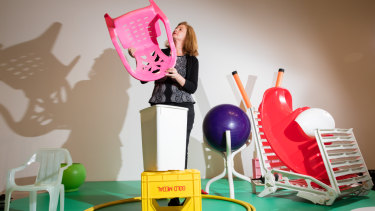
"I think Australians are particularly suited to theft as a strategy in art – and that particular type of theft where it’s not just formal borrowing like you might see the Cubist do, for example, but actually saying, 'this is what I’m taking, you’d better notice that because this is the way I am transforming it and thus transforming the language and the meaning'.”

Louise Paramor with her "strange and joyous" work.Credit:Janie Barrett
Among the works in Caught Stealing is a piece from New York-based, two-person collective Soda Jerk in collaboration with Melbourne band The Avalanches. Called The Was, and variously described as “part experimental film, part music video and concept album”, the film is made up entirely of “stolen” clips and images.
“It’s really pushing the limits of copyright,” says Tsai.
Elsewhere, Indigenous artist Daniel Boyd exhibits empty “skull boxes” that once contained stolen Aboriginal skulls in London’s Natural History Museum.
"That really spoke to him of a history of using Aboriginal bodies as artefacts,” says Tsai. “They are chillingly bureaucratic until you look at them and you start to see, ‘Oh, OK, this is what was actually inside.'
"It's a way of looking at the way Indigenous bodies have belonged to a taxonomy of objects historically.”
Loading
The drab boxes couldn’t contrast more with Louise Paramor’s brilliantly coloured assemblage of familiar objects, including patio furniture, children’s toys and exercise balls.
Slyly subversive, Paramor asks the viewer to reconsider these everyday objects that have been removed from their usual context.
"You recognise where they come from,” says Tsai. “But they are transformed into these strange characters and they are joyous."
Caught Stealing is at the National Art School, Darlinghurst, until August 10
Nick Galvin is Arts Editor of The Sydney Morning Herald




























